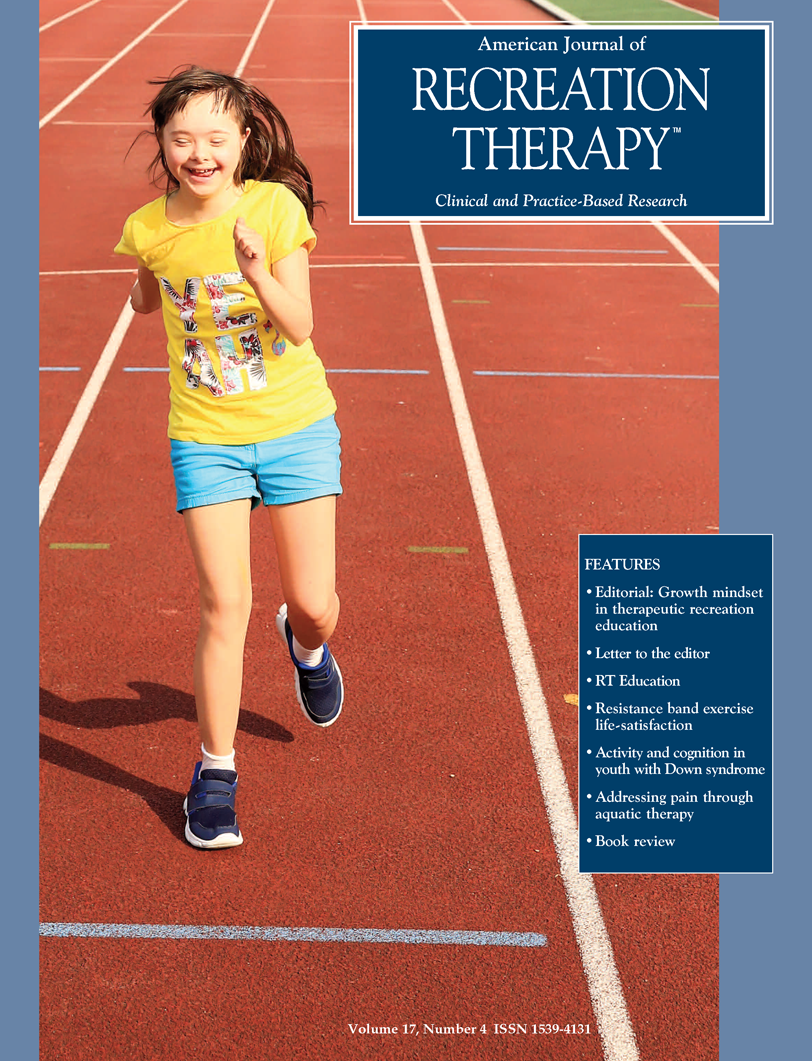Addressing osteoarthritis pain among older adult women through aquatic therapy: A new look at shallow-water movement
DOI:
https://doi.org/10.5055/ajrt.2018.0173Keywords:
aquatic-therapy, functional-movement, older-adults, osteoarthritis, painAbstract
This study evaluated a shallow-water intervention to reduce pain among women age 61 to 81 with knee and/or hip osteoarthritis. The study used a randomized-replicated single-case two-condition crossover design to determine which condition was more effective at relieving pain. One condition was functional movements without the use of a stationary pole; the other condition, identical movements with the pole. Data were collected through repeated pain measures, pre-test-post-test measures, and retrospective pre-test post-test measures. Pain data analysis with Microsoft Excel® ExPRT 2.0 AB program generated pre- and post-crossover charts. Visual analysis findings were substantiated with sensitivity analyses of retrospective pre-test and post-test data, showing no significance between the two conditions (p ≤ 0.05). Results indicated use of a pole might not be more effective than the movement program itself. For the individual and recreation therapist, this finding might translate to cost effective recreation therapy interventions addressing clinical outcomes as a result from engagement with an aquatic RT movement program.
References
Fisken A, Waters DL, Hing WA, et al.: Perception and responses to different forms of aqua-based exercise among older adults with osteoarthritis. Int J Aquatic Res Edu. 2014; 8(1): 32-52.
Lu M, Su Y, Zhang Y, et al.: Effectiveness of aquatic exercise for treatment of knee osteoarthritis: Systematic review and meta-analysis. Z Rheumatol. 2015; 74(6): 543-552.
Austin DR, Crawford ME, McCormick BP, et al. (eds.): Recreational Therapy: An Introduction. 4th ed. Urbana, IL: Sagamore Publishing LLC, 2015.
Mailey E, McAuley E: Physical activity intervention effects on perceived stress in working mothers: The role of self-efficacy. Women Health. 2014; 54(6): 552-568.
Piatt J, Compton DM, Wells MS, et al.: Interventions that effect active living among individuals with spinal cord injury. Ther Recreation J. 2012; 46(1): 9-25.
Rose A, Piatt JA, Zahl M, et al.: The effect of a self-efficacy based forum on life satisfaction for individuals with spinal cord injury or disease. Annu Ther Recreation. 2008; 16: 49-56.
Tse M, Leung R, Ho S: Pain and psychological well-being of older persons living in nursing homes: An exploratory study in planning patient-centered intervention. J Adv Nurs. 2012; 68(2): 312-321.
Fisken A, Keogh JWL, Hing WA, et al.: Perceived benefits, motives, and barriers to aqua-based exercise among older adults with and without osteoarthritis. J Appl Gerontol. 2015; 34(3): 377-396.
Kinghorn P, Robinson A, Smith R: Developing a capability-based questionnaire for assessing well-being in patients with chronic pain. Soc Indic Res. 2014; 120(3): 897-916.
Shrestha S, Schofield P, Devkota R: A critical literature review on non-pharmacological approaches used by older people in chronic pain management. Indian J Gerontol. 2013; 27(1): 135-161.
Volkow ND: America’s addiction to opioids: Heroin and prescription drug abuse. Paper presented at: Senate Caucus on International Narcotics Control, May 14, 2014; Washington, DC. Available at https://www.drugabuse.gov/about-nida/legislative-activities/testimony-to-congress/2014/americas-addiction-to-opioids-heroin-prescription-drugabuse. Accessed March 11, 2018.
Park J, Hirz CE, Manotas K, et al.: Nonpharmacological pain management by ethnically diverse older adults with chronic pain: Barriers and facilitators. J Gerontol Soc Work. 2013; 56(6): 487-508.
Okada T, Huxel KC, Nesser TW: Relationship between core stability, #functional |movement, and performance. J Strength Cond Res. 2011; 25(1): 252-261.
Liu C-J, Shiroy DM, Jones LY, et al.: Systematic review of functional training on muscle strength, #physical |functioning, and activities of daily living in older adults. Eur Rev Aging Phys Act. 2014; 11(2): 95-106.
Kratochwill TR, Levin JR: Enhancing scientific credibility of single-case intervention research: Randomization to the rescue. Psychol Methods. 2005; 15(2): 124-144.
Kazdin AE: Single-Case Research Designs: Methods for Clinical and Applied Settings. New York, NY: Oxford University Press, 1982.
Hawker GA, Mian S, Kendzerska T, et al.: Measures of adult pain. Arthritis Care Res. 2011; 63(S11): S240-S252.
Salaffi F, Stancati A, Silvestri CA, et al.: Minimal clinically important changes in chronic musculoskeletal pain intensity measured on a numerical rating scale. Eur J Pain. 2004; 8(4): 283-291.
Kratochwill TR, Hitchcock J, Horner RH, et al.: Single-case designs technical documentation. Available at http://ies.ed.gov/ncee/wwc/documentsum.aspx?sid=229. Accessed July 16, 2018.
Levin JR, Eumenova AS, Gafurov BS: Single-case data-analysis ExPRT (Excel Package of Randomization Tests). In Kratochwill TR, Levin JR (eds.): Single-Case Intervention Research: Methodological and Statistical Advances. Washington, DC: American Psychological Association, 2014: 185-219.
Revelle WR: Procedures for personality and psychological research (Version 1.7.5.). Available at https://CRAN.Rproject.org/package=psych. Accessed June 22, 2017.
SAS Institute: Base SAS® 9.4 Procedures Guide: Statistical Procedures. 5th ed. Cary, NC: SAS Institute Inc., 2015.
Bartels EM, Juhl CB, Christensen R, et al.: Aquatic exercise for the treatment of knee and hip osteoarthritis. Cochrane Database Syst Rev. 2016; 3: CD005523.
Johnson SR, Keyan Z, Rosario ER: Effects of aquatic therapy on functional mobility and strength, #fall |risk, and self-reported disability in individuals with low back pain. J Aquatic Phys Ther. 2016; 24(1): 22-31.
Waller B, Ogonowska-Slowdownik A, Manuel V, et al.: Effect of therapeutic aquatic exercise on symptoms and function associated with lower limb osteoarthritis: Systematic review with meta-analysis. J Phys Ther. 2014; 94(10): 1319-1395.
Published
How to Cite
Issue
Section
License
Copyright 2000-2025, Weston Medical Publishing, LLC and American Journal of Recreation Therapy. All Rights Reserved.


